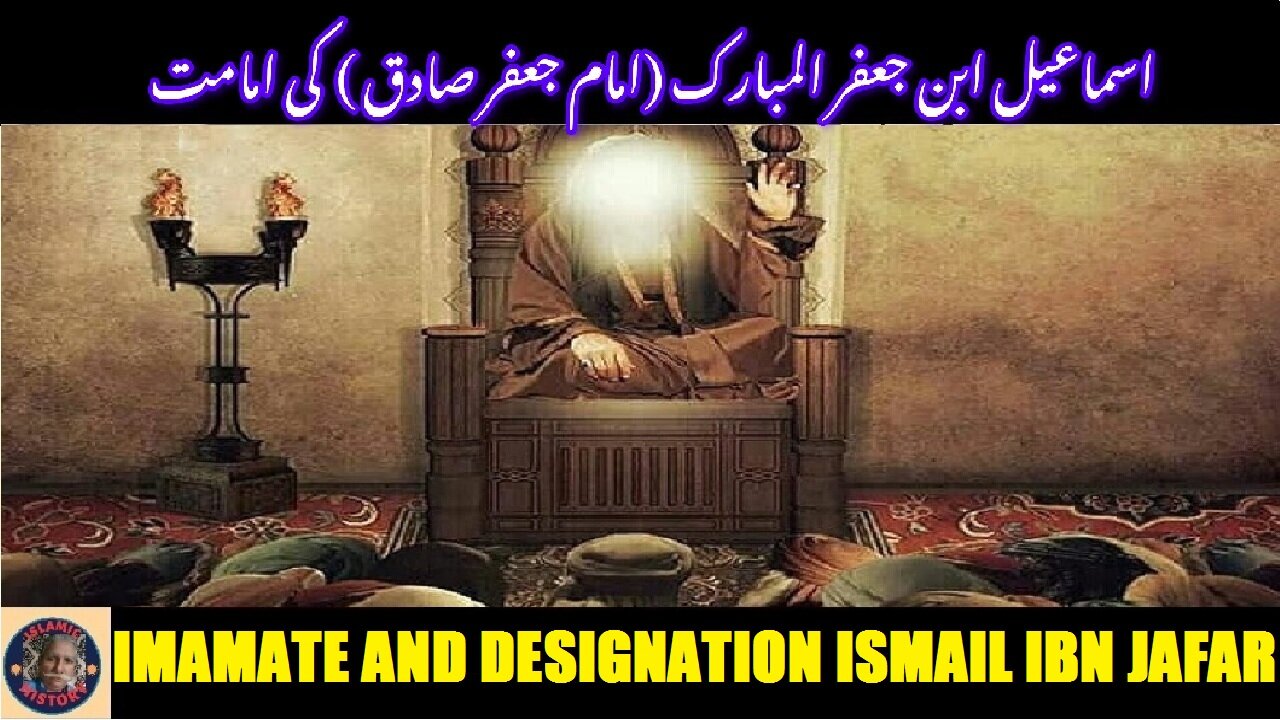Premium Only Content

Imamate and Designation of Ismail ibn Jafar al-Mubarak اسماعیل ابن جعفر المبارک کی امامت اور عہدہ
@islamichistory813 #IslamicHistory #IsmailIbnJafar #Leadership
Imamate and Designation, of Islamic warrior Ismail ibn Jafar al-Mubarak
Dekhti Aankhooon aur sountay kaanoon ko Asslamoalaikum, sisters, brothers friends and elders, This video delves into the significant role of Ismail ibn Jafar al-Mubarak in Islamic history, focusing on his imamate and designation as a prominent warrior. We are describing his contributions to the Islamic faith, his leadership qualities, and the impact of his actions on the community during his time. Please be with us and watch complete video upto end as we are describing the legacy of this influential figure and his enduring significance in Islamic tradition.
According to the majority of the available sources, al-Sadiq had indeed designated al-Mubarak by nass (divine decree) as his successor in Imamate. This fact was accepted as the formal act of nass required by Shia theory and was therefore a designation by an infallible Imam of the new Imam who would inherit the full powers of the Imamate. Al-Mubarak was thus not only al-Sadiq's choice but was God's choice as well. This designation, in fact, forms the basis of Isma'ili claims and which should have settled the question of al-Sadiq's succession in due course. According to the Isma'ili tradition, when al-Mubarak was seven years of age, al-Sadiq declared his Imamate. He was separated from his other brothers and kept away from contact with the public. Al-Sadiq himself undertook his education. As da'i Idris observes, this declaration was made secretly on the basis of taqiyya. Only certain selected followers of al-Sadiq knew this fact. Apparently, though, al-Sadiq did not appoint another in place of al-Mubarak and the theoretical argument by which he might have done so is, generally speaking, missing; although the later Twelver Shias claimed such a nass for Musa ibn Ja'far al-Kazim, the younger half brother of al-Mubarak, producing several hadiths to this effect. Twelver writers like al-Nawbakhti admitted as much even a hundred years after the fact.
After the death of al-Sadiq a great confusion arose amongst his sons as each of his surviving sons claimed the Imamate but could not produce sufficient credentials, and so their followers melted away in a short period expect for two candidates: al-Mubarak and al-Kazim. Al-Mubarak was some twenty-five years older than his half-brother al-Kazim, who was born in 128/745–46 to a Berber slave-girl. Various historians relate that "all" of the sons of al-Sadiq contended for the position. In Kalam-i Pir, an Isma'ili work wrongly attributed to Nasir Khusraw, there is an account of this contest, which was again carried for decision to the Black Stone at Mecca, as had been done by Zayn al-Abidin and Muhammad ibn al-Hanafiyya. This time the decision was in favour of al-Mubarak, after which al-Kazim swears allegiance to him.
Various reasons are given as an explanation for altering the nass al-Sadiq had given to al-Mubarak. That most frequently used by historians, mostly Sunni and Twelver, is that al-Mubarak had been drinking, to which the Isma'ili could reply, that the Imam being infallible would know a truth concerning drinking beyond the zahir command to abstain from it. More likely, It deserves to note that some bombastic stories of al-Mubarak's indulgence in drink and his alleged association with the extremists have been condemned by many historians. Mufaddal ibn Umar al-Sayrafi however relates that al-Sadiq, in view of his son's piety had already warned the people in Medina that, "Do not wrong Isma'il" (la tajafu Isma'ila).
With regard to the Twelver Shia claims that al-Mubarak had pre-deceased al-Sadiq, the Isma'ilis believe that al-Sadiq observed taqiya (dissimulation) and gave a chance to his real successor to go underground so that their enemy, the Abbasids, did not pursue al-Mubarak, and that his Imamate and his activities went un-noticed. Thus al-Kazim who was believed to be poisoned by the Abbasid Caliph Harun was in fact a veil (hijab) for al-Mubarak. The Sunni historian Rashid al-Din Hamadani wrote that some Isma'ilis believed that al-Kazim willingly gave his life for the sake of his elder brother al-Mubarak, the true Imam. The Isma'ilis further argued that the Imam being ma'sum (infallible) could not make an error of Judgement and therefore the first nass (designation) of al-Sadiq was the correct one.[22] Thus, this group accepted al-Mubarak as their Imam and are known as Isma'iliyya or Isma'ilis.
Relations with radical Shias
Al-Mubarak evidently had contacts with the activist Shias in his father's following, including al-Mufaddal ibn Umar al-Ju'fi. According to the historian al-Maqrizi, al-Mufaddal regarded al-Sadiq as God, so the Imam repudiated him and publicly cursed him. Al-Mubarak, who was reportedly involved in certain anti-Abbasid plots, may also have collaborated with Abu al-Khattab al-Asadi, another activist Shia originally in the entourage of al-Sadiq. Abu al-Khattab had been active in the Shia group with al-Sadiq, but the latter had to repudiate him openly, because of his extremist theological view, which he had endeavoured to enforce by militant means, though Abu al-Khattab supposedly maintained that the repudiation was part of al-Sadiq's technique at preserving his true nature. The Asr?r also states that al-Sadiq had to forbid al-Mubarak to go to the school which Abu al-Khattab had been conducting.
Louis Massignon has suggested that Abu al-Khattab was the spiritual or adoptive father of al-Mubarak, hence his kunya of Abu Isma'il. In this connection, he formulated a general hypothesis, contending that since the beginning of the second Islamic century, the expression anta minna Ahl al-Bayt ('you are from the Prophet's family') purportedly used by Muhammad in reference to Salman the Persian, and as reported in a hadith, had acquired a ritual value indicating 'spiritual adoption' amongst the revolutionary Shias, for whom real family ties were established through spiritual parentage, adoption or initiation.Possible collaboration between al-Mubarak and Abu al-Khattab remains shrouded in obscurity, despite the fact that the Twelver sources, generally hostile to the Isma'ilis, identify the nascent Isma'ili with the early Khattabiyya; the later Isma'ilis regarded Abu al-Khattab as a heretic and repudiated the Khattabiyya.
so sisters brothers friends and elders, tomorow we are going to described The doctrine of Islamic warrior leader Ismail ibn Jafar al-Mubarak. Allah hafiz
========================================
-
 13:26
13:26
ISLAMIC HISTORY
1 day agoIslamic History Episode 241 The Dethronement and Death of Mu'taz Billah معتز بلہ کی معزولی اور وفات
81 -
 1:33:53
1:33:53
Inverted World Live
5 hours agoMan Sees Creature in Loch Ness | Ep. 116
34.3K4 -
 3:04:06
3:04:06
PandaSub2000
15 hours agoLIVE 10pm ET | EXORCIST LEGION VR (Horror In VR!)
8.74K1 -

SmashJT
2 hours agoCollective Shout Keeps “HARRASSING” Me | Smashcast
13.7K1 -
 DVR
DVR
StevieTLIVE
3 hours agoWarzone Wins ALL Night w/ GloryJean
16.6K1 -
 3:22:50
3:22:50
Laura Loomer
7 hours agoEP146: Loomer EXPOSES Big Tech's Complicity With Anti-ICE Violence
38.2K12 -
 31:39
31:39
Standpoint with Gabe Groisman
1 day ago“Most People Have NO IDEA What Isolationism could do to America” Rep Rich McCormick Joins Standpoint
15.6K4 -
 2:34:31
2:34:31
MissesMaam
5 hours ago75% DONE WITH PERFECTION!!! | Stardew Co-Op 💚✨
14.9K3 -
 LIVE
LIVE
Clenzd Gaming
4 hours ago $0.42 earnedThe Return
95 watching -
 1:20:44
1:20:44
DeafWarriorLegendary
3 hours ago🔥Deaf Streamer🔥
7.99K